Global Leadership & Organizational Behaviour: Unilever Case
VerifiedAdded on 2023/06/16
|12
|4049
|221
Report
AI Summary
This report provides an overview of global leadership and organizational behaviour, examining various leadership theories such as transactional, transformational, and charismatic leadership, with a focus on Unilever's strategies. It discusses the functions of leaders, including setting goals, organizing, taking initiatives, fostering cooperation, providing motivation, and making policies. The report also identifies sources of leadership power, such as coercive, reward, legitimate, expert, and referent power, and explores aspects influencing leadership effectiveness. Ultimately, the report aims to demonstrate an understanding of how effective leadership and management behaviour can influence organizational performance in a global market environment.
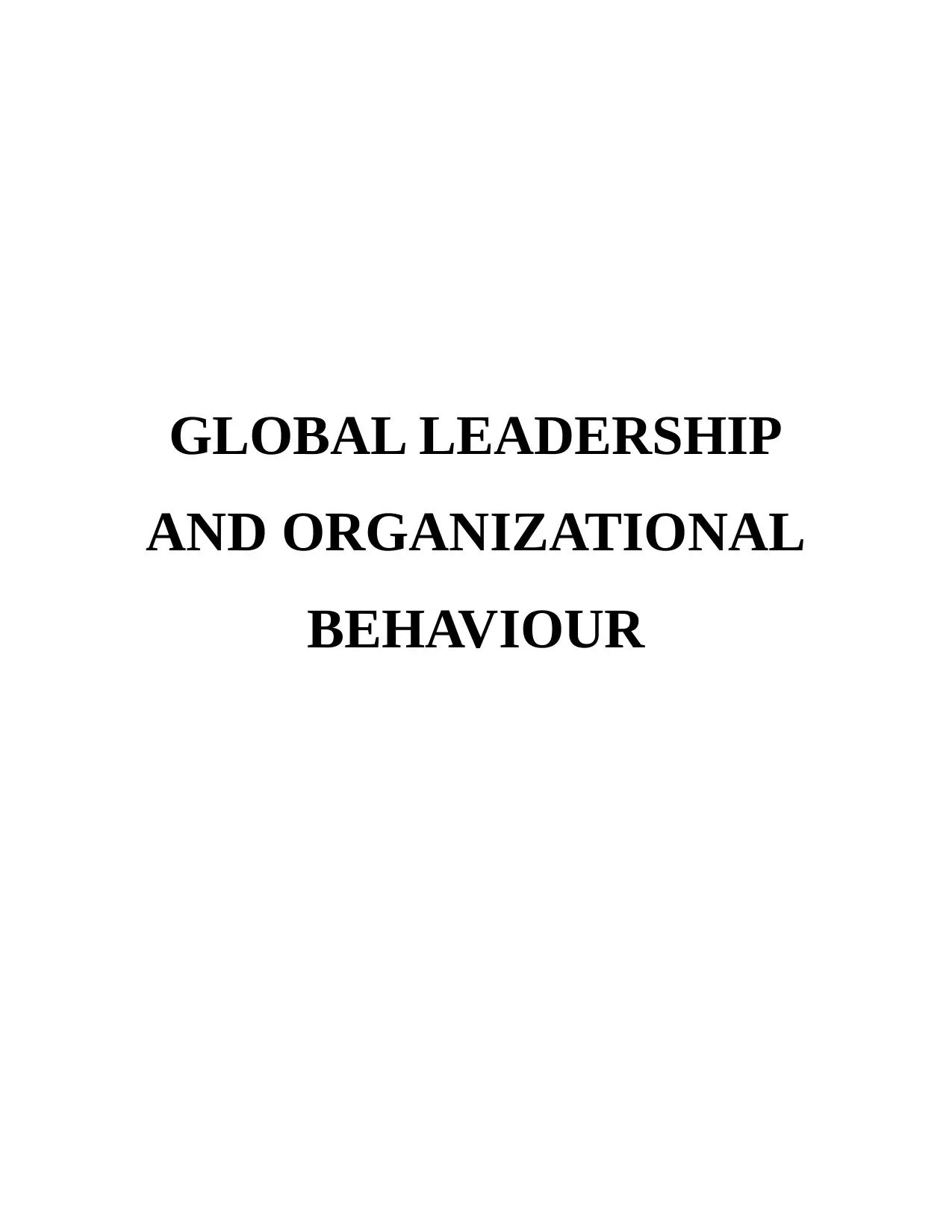
GLOBAL LEADERSHIP
AND ORGANIZATIONAL
BEHAVIOUR
AND ORGANIZATIONAL
BEHAVIOUR
Paraphrase This Document
Need a fresh take? Get an instant paraphrase of this document with our AI Paraphraser
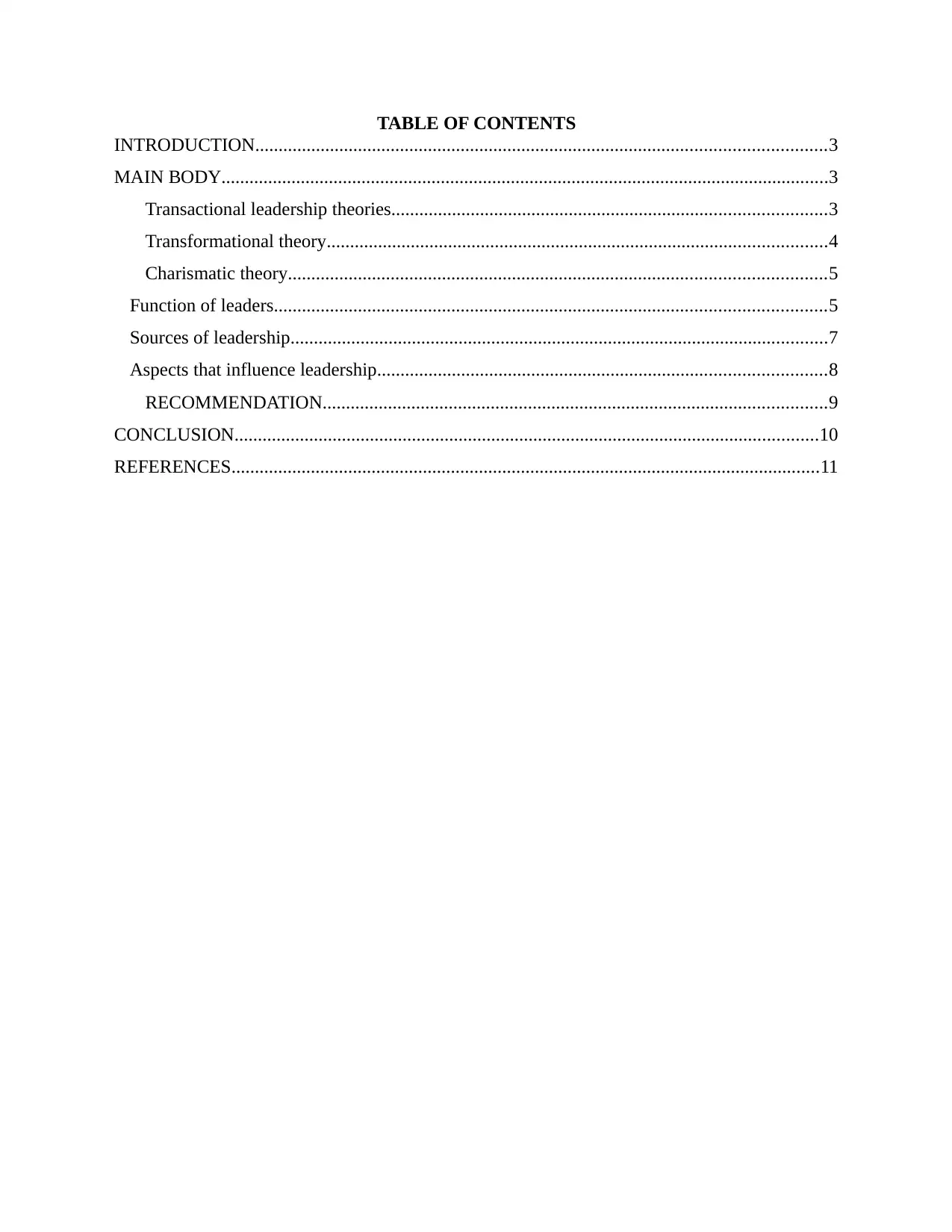
TABLE OF CONTENTS
INTRODUCTION..........................................................................................................................3
MAIN BODY..................................................................................................................................3
Transactional leadership theories.............................................................................................3
Transformational theory...........................................................................................................4
Charismatic theory...................................................................................................................5
Function of leaders......................................................................................................................5
Sources of leadership...................................................................................................................7
Aspects that influence leadership................................................................................................8
RECOMMENDATION............................................................................................................9
CONCLUSION.............................................................................................................................10
REFERENCES..............................................................................................................................11
INTRODUCTION..........................................................................................................................3
MAIN BODY..................................................................................................................................3
Transactional leadership theories.............................................................................................3
Transformational theory...........................................................................................................4
Charismatic theory...................................................................................................................5
Function of leaders......................................................................................................................5
Sources of leadership...................................................................................................................7
Aspects that influence leadership................................................................................................8
RECOMMENDATION............................................................................................................9
CONCLUSION.............................................................................................................................10
REFERENCES..............................................................................................................................11
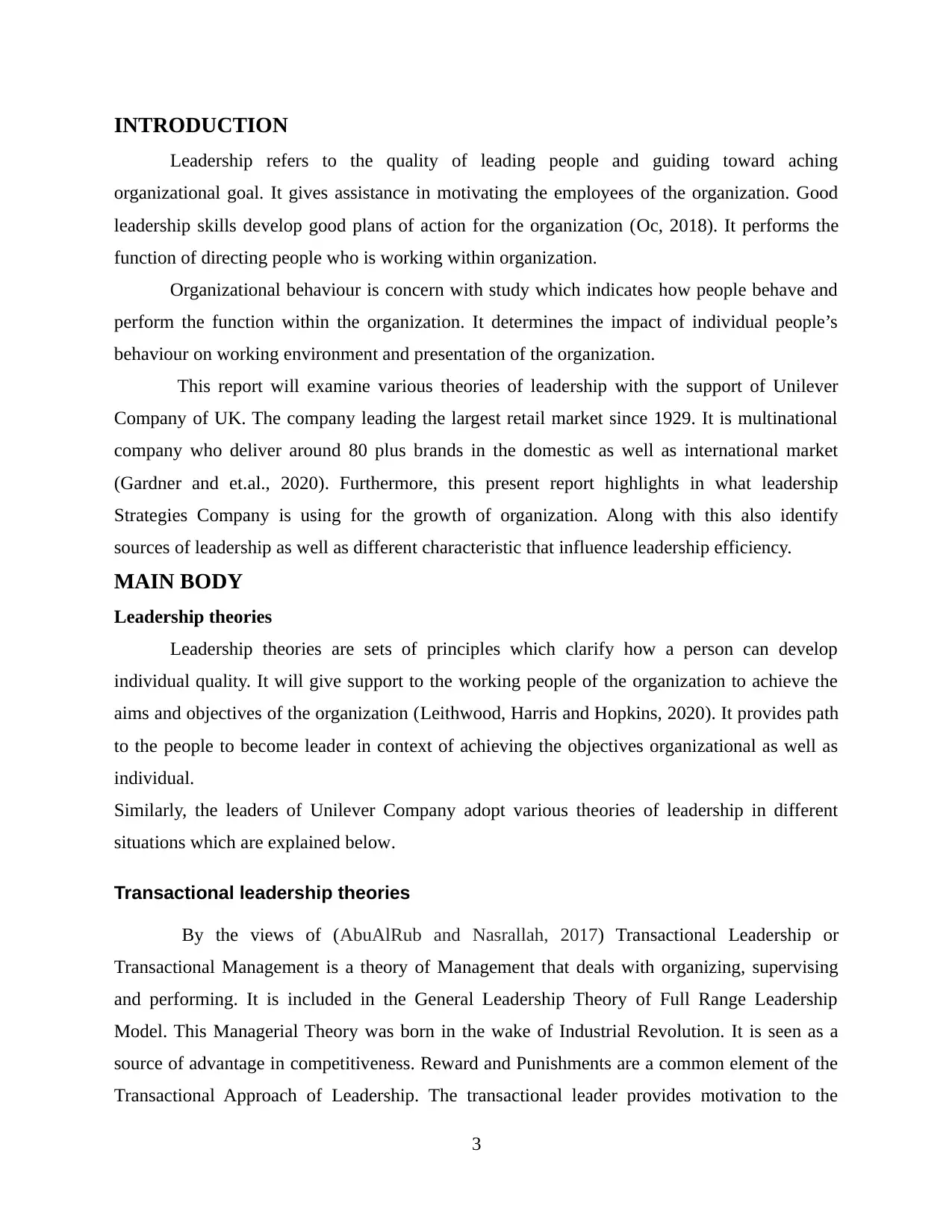
INTRODUCTION
Leadership refers to the quality of leading people and guiding toward aching
organizational goal. It gives assistance in motivating the employees of the organization. Good
leadership skills develop good plans of action for the organization (Oc, 2018). It performs the
function of directing people who is working within organization.
Organizational behaviour is concern with study which indicates how people behave and
perform the function within the organization. It determines the impact of individual people’s
behaviour on working environment and presentation of the organization.
This report will examine various theories of leadership with the support of Unilever
Company of UK. The company leading the largest retail market since 1929. It is multinational
company who deliver around 80 plus brands in the domestic as well as international market
(Gardner and et.al., 2020). Furthermore, this present report highlights in what leadership
Strategies Company is using for the growth of organization. Along with this also identify
sources of leadership as well as different characteristic that influence leadership efficiency.
MAIN BODY
Leadership theories
Leadership theories are sets of principles which clarify how a person can develop
individual quality. It will give support to the working people of the organization to achieve the
aims and objectives of the organization (Leithwood, Harris and Hopkins, 2020). It provides path
to the people to become leader in context of achieving the objectives organizational as well as
individual.
Similarly, the leaders of Unilever Company adopt various theories of leadership in different
situations which are explained below.
Transactional leadership theories
By the views of (AbuAlRub and Nasrallah, 2017) Transactional Leadership or
Transactional Management is a theory of Management that deals with organizing, supervising
and performing. It is included in the General Leadership Theory of Full Range Leadership
Model. This Managerial Theory was born in the wake of Industrial Revolution. It is seen as a
source of advantage in competitiveness. Reward and Punishments are a common element of the
Transactional Approach of Leadership. The transactional leader provides motivation to the
3
Leadership refers to the quality of leading people and guiding toward aching
organizational goal. It gives assistance in motivating the employees of the organization. Good
leadership skills develop good plans of action for the organization (Oc, 2018). It performs the
function of directing people who is working within organization.
Organizational behaviour is concern with study which indicates how people behave and
perform the function within the organization. It determines the impact of individual people’s
behaviour on working environment and presentation of the organization.
This report will examine various theories of leadership with the support of Unilever
Company of UK. The company leading the largest retail market since 1929. It is multinational
company who deliver around 80 plus brands in the domestic as well as international market
(Gardner and et.al., 2020). Furthermore, this present report highlights in what leadership
Strategies Company is using for the growth of organization. Along with this also identify
sources of leadership as well as different characteristic that influence leadership efficiency.
MAIN BODY
Leadership theories
Leadership theories are sets of principles which clarify how a person can develop
individual quality. It will give support to the working people of the organization to achieve the
aims and objectives of the organization (Leithwood, Harris and Hopkins, 2020). It provides path
to the people to become leader in context of achieving the objectives organizational as well as
individual.
Similarly, the leaders of Unilever Company adopt various theories of leadership in different
situations which are explained below.
Transactional leadership theories
By the views of (AbuAlRub and Nasrallah, 2017) Transactional Leadership or
Transactional Management is a theory of Management that deals with organizing, supervising
and performing. It is included in the General Leadership Theory of Full Range Leadership
Model. This Managerial Theory was born in the wake of Industrial Revolution. It is seen as a
source of advantage in competitiveness. Reward and Punishments are a common element of the
Transactional Approach of Leadership. The transactional leader provides motivation to the
3
⊘ This is a preview!⊘
Do you want full access?
Subscribe today to unlock all pages.

Trusted by 1+ million students worldwide
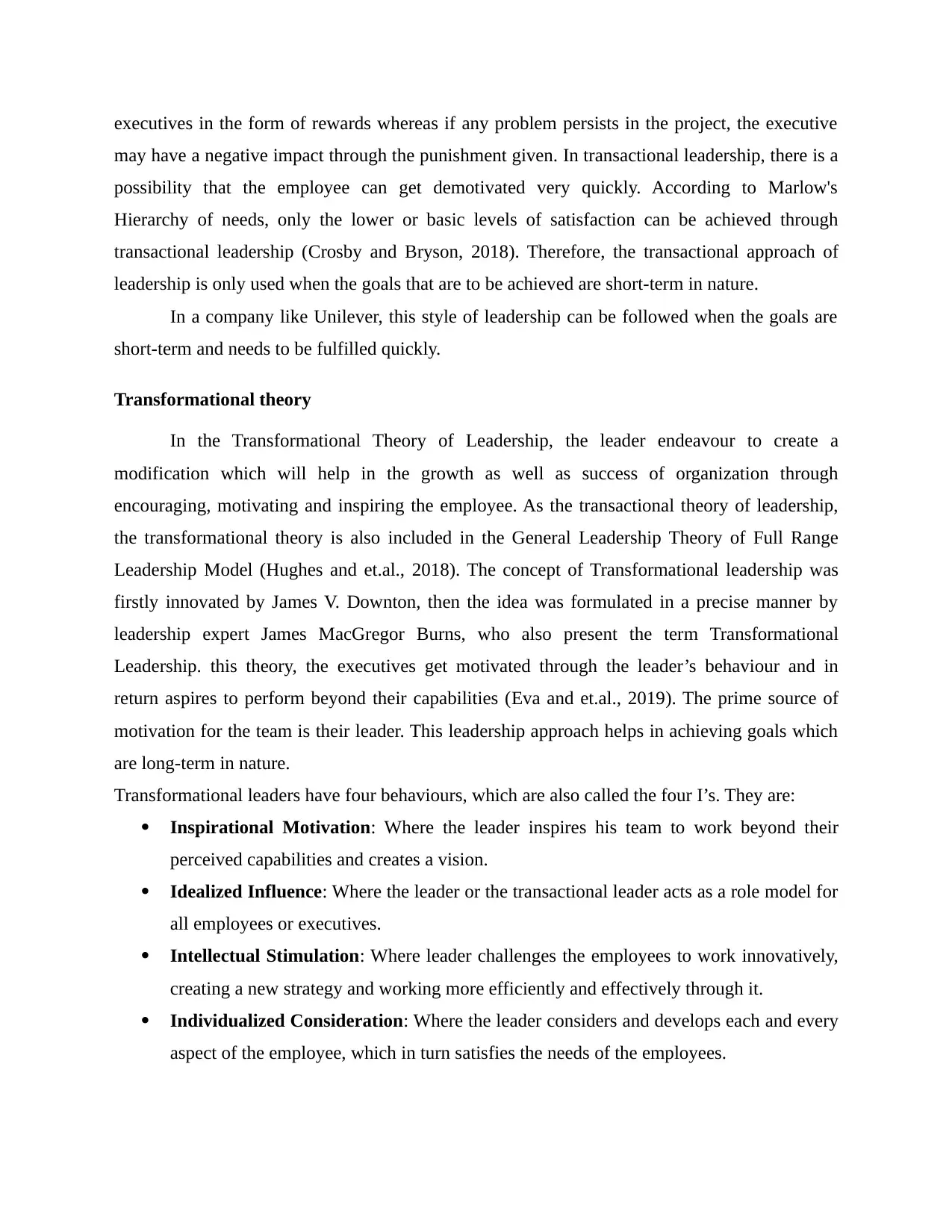
executives in the form of rewards whereas if any problem persists in the project, the executive
may have a negative impact through the punishment given. In transactional leadership, there is a
possibility that the employee can get demotivated very quickly. According to Marlow's
Hierarchy of needs, only the lower or basic levels of satisfaction can be achieved through
transactional leadership (Crosby and Bryson, 2018). Therefore, the transactional approach of
leadership is only used when the goals that are to be achieved are short-term in nature.
In a company like Unilever, this style of leadership can be followed when the goals are
short-term and needs to be fulfilled quickly.
Transformational theory
In the Transformational Theory of Leadership, the leader endeavour to create a
modification which will help in the growth as well as success of organization through
encouraging, motivating and inspiring the employee. As the transactional theory of leadership,
the transformational theory is also included in the General Leadership Theory of Full Range
Leadership Model (Hughes and et.al., 2018). The concept of Transformational leadership was
firstly innovated by James V. Downton, then the idea was formulated in a precise manner by
leadership expert James MacGregor Burns, who also present the term Transformational
Leadership. this theory, the executives get motivated through the leader’s behaviour and in
return aspires to perform beyond their capabilities (Eva and et.al., 2019). The prime source of
motivation for the team is their leader. This leadership approach helps in achieving goals which
are long-term in nature.
Transformational leaders have four behaviours, which are also called the four I’s. They are:
Inspirational Motivation: Where the leader inspires his team to work beyond their
perceived capabilities and creates a vision.
Idealized Influence: Where the leader or the transactional leader acts as a role model for
all employees or executives.
Intellectual Stimulation: Where leader challenges the employees to work innovatively,
creating a new strategy and working more efficiently and effectively through it.
Individualized Consideration: Where the leader considers and develops each and every
aspect of the employee, which in turn satisfies the needs of the employees.
may have a negative impact through the punishment given. In transactional leadership, there is a
possibility that the employee can get demotivated very quickly. According to Marlow's
Hierarchy of needs, only the lower or basic levels of satisfaction can be achieved through
transactional leadership (Crosby and Bryson, 2018). Therefore, the transactional approach of
leadership is only used when the goals that are to be achieved are short-term in nature.
In a company like Unilever, this style of leadership can be followed when the goals are
short-term and needs to be fulfilled quickly.
Transformational theory
In the Transformational Theory of Leadership, the leader endeavour to create a
modification which will help in the growth as well as success of organization through
encouraging, motivating and inspiring the employee. As the transactional theory of leadership,
the transformational theory is also included in the General Leadership Theory of Full Range
Leadership Model (Hughes and et.al., 2018). The concept of Transformational leadership was
firstly innovated by James V. Downton, then the idea was formulated in a precise manner by
leadership expert James MacGregor Burns, who also present the term Transformational
Leadership. this theory, the executives get motivated through the leader’s behaviour and in
return aspires to perform beyond their capabilities (Eva and et.al., 2019). The prime source of
motivation for the team is their leader. This leadership approach helps in achieving goals which
are long-term in nature.
Transformational leaders have four behaviours, which are also called the four I’s. They are:
Inspirational Motivation: Where the leader inspires his team to work beyond their
perceived capabilities and creates a vision.
Idealized Influence: Where the leader or the transactional leader acts as a role model for
all employees or executives.
Intellectual Stimulation: Where leader challenges the employees to work innovatively,
creating a new strategy and working more efficiently and effectively through it.
Individualized Consideration: Where the leader considers and develops each and every
aspect of the employee, which in turn satisfies the needs of the employees.
Paraphrase This Document
Need a fresh take? Get an instant paraphrase of this document with our AI Paraphraser
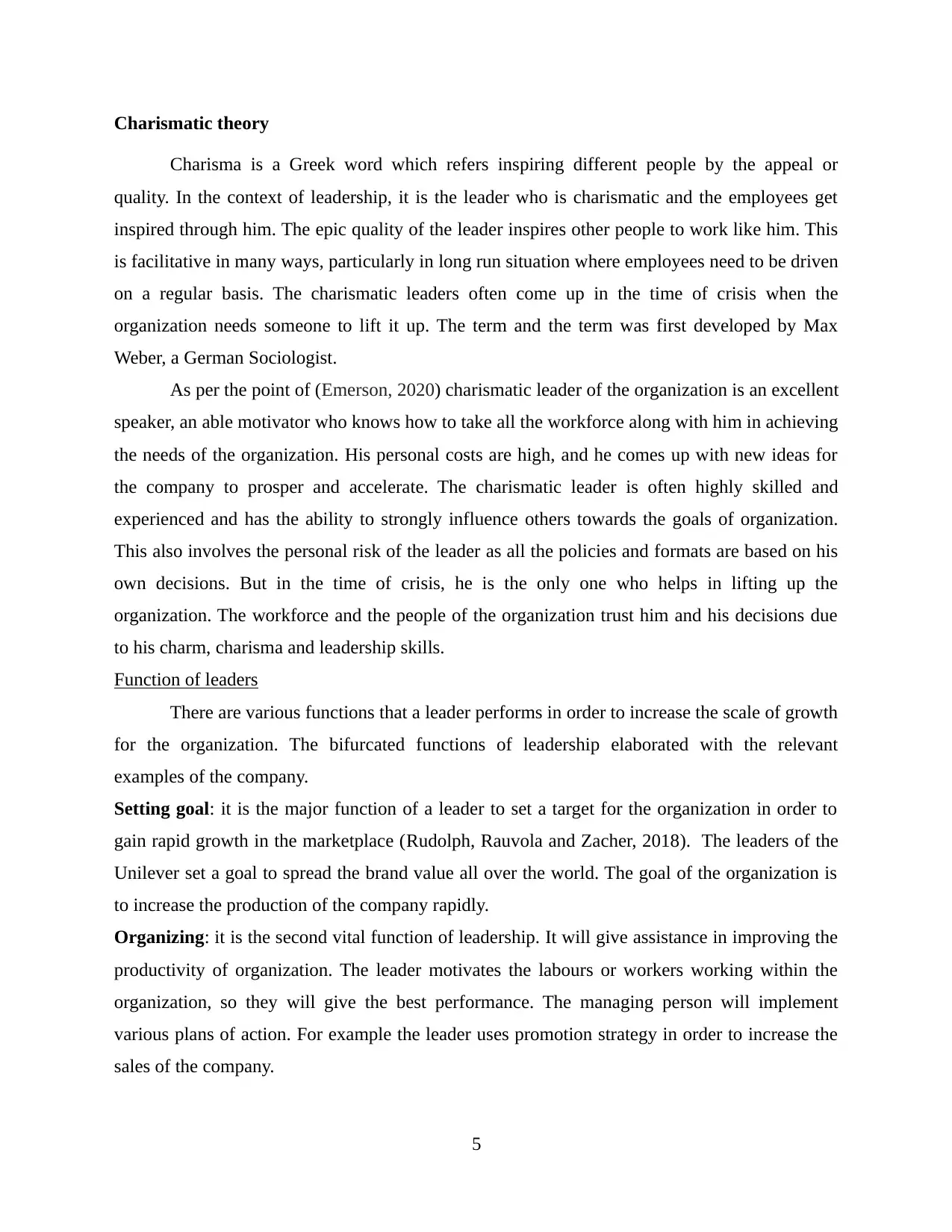
Charismatic theory
Charisma is a Greek word which refers inspiring different people by the appeal or
quality. In the context of leadership, it is the leader who is charismatic and the employees get
inspired through him. The epic quality of the leader inspires other people to work like him. This
is facilitative in many ways, particularly in long run situation where employees need to be driven
on a regular basis. The charismatic leaders often come up in the time of crisis when the
organization needs someone to lift it up. The term and the term was first developed by Max
Weber, a German Sociologist.
As per the point of (Emerson, 2020) charismatic leader of the organization is an excellent
speaker, an able motivator who knows how to take all the workforce along with him in achieving
the needs of the organization. His personal costs are high, and he comes up with new ideas for
the company to prosper and accelerate. The charismatic leader is often highly skilled and
experienced and has the ability to strongly influence others towards the goals of organization.
This also involves the personal risk of the leader as all the policies and formats are based on his
own decisions. But in the time of crisis, he is the only one who helps in lifting up the
organization. The workforce and the people of the organization trust him and his decisions due
to his charm, charisma and leadership skills.
Function of leaders
There are various functions that a leader performs in order to increase the scale of growth
for the organization. The bifurcated functions of leadership elaborated with the relevant
examples of the company.
Setting goal: it is the major function of a leader to set a target for the organization in order to
gain rapid growth in the marketplace (Rudolph, Rauvola and Zacher, 2018). The leaders of the
Unilever set a goal to spread the brand value all over the world. The goal of the organization is
to increase the production of the company rapidly.
Organizing: it is the second vital function of leadership. It will give assistance in improving the
productivity of organization. The leader motivates the labours or workers working within the
organization, so they will give the best performance. The managing person will implement
various plans of action. For example the leader uses promotion strategy in order to increase the
sales of the company.
5
Charisma is a Greek word which refers inspiring different people by the appeal or
quality. In the context of leadership, it is the leader who is charismatic and the employees get
inspired through him. The epic quality of the leader inspires other people to work like him. This
is facilitative in many ways, particularly in long run situation where employees need to be driven
on a regular basis. The charismatic leaders often come up in the time of crisis when the
organization needs someone to lift it up. The term and the term was first developed by Max
Weber, a German Sociologist.
As per the point of (Emerson, 2020) charismatic leader of the organization is an excellent
speaker, an able motivator who knows how to take all the workforce along with him in achieving
the needs of the organization. His personal costs are high, and he comes up with new ideas for
the company to prosper and accelerate. The charismatic leader is often highly skilled and
experienced and has the ability to strongly influence others towards the goals of organization.
This also involves the personal risk of the leader as all the policies and formats are based on his
own decisions. But in the time of crisis, he is the only one who helps in lifting up the
organization. The workforce and the people of the organization trust him and his decisions due
to his charm, charisma and leadership skills.
Function of leaders
There are various functions that a leader performs in order to increase the scale of growth
for the organization. The bifurcated functions of leadership elaborated with the relevant
examples of the company.
Setting goal: it is the major function of a leader to set a target for the organization in order to
gain rapid growth in the marketplace (Rudolph, Rauvola and Zacher, 2018). The leaders of the
Unilever set a goal to spread the brand value all over the world. The goal of the organization is
to increase the production of the company rapidly.
Organizing: it is the second vital function of leadership. It will give assistance in improving the
productivity of organization. The leader motivates the labours or workers working within the
organization, so they will give the best performance. The managing person will implement
various plans of action. For example the leader uses promotion strategy in order to increase the
sales of the company.
5
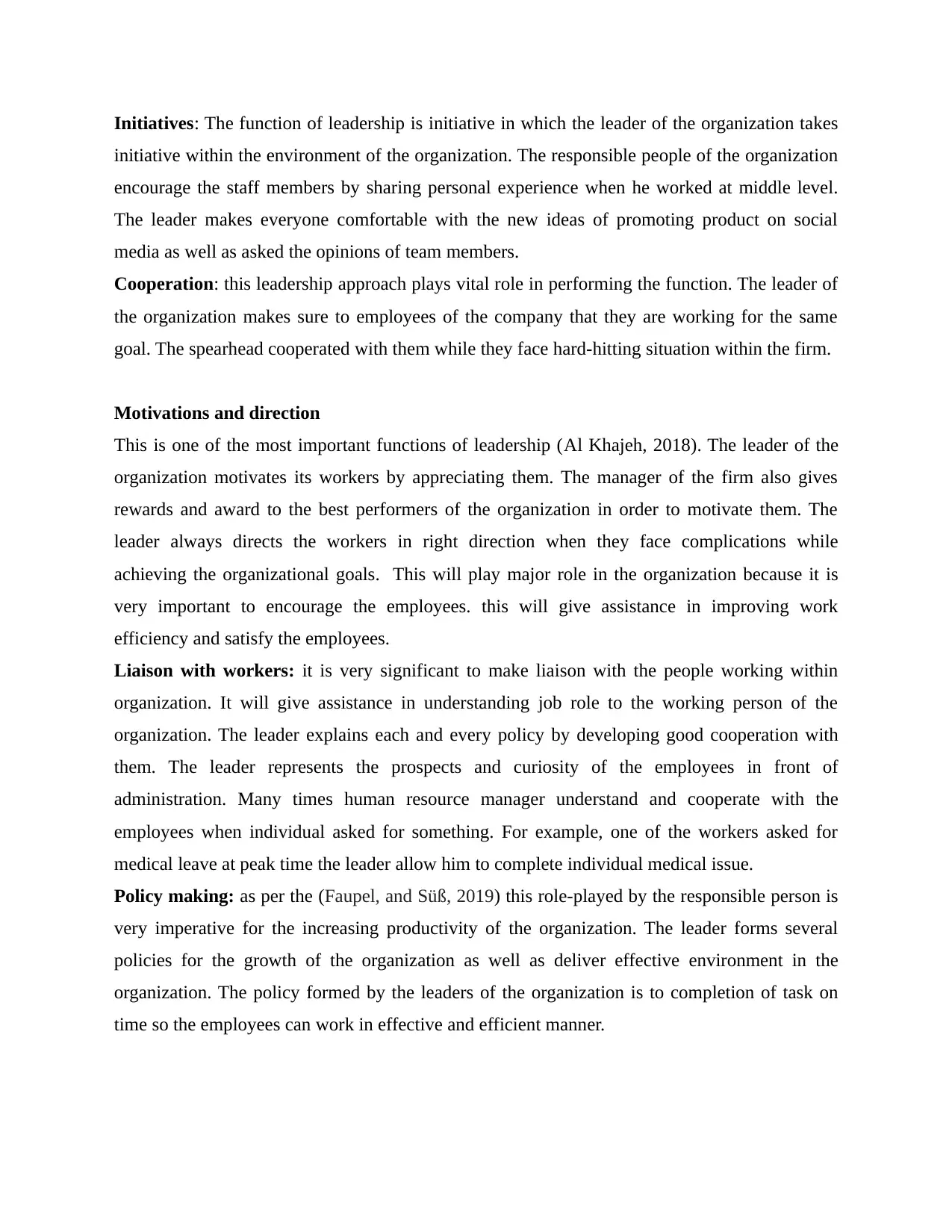
Initiatives: The function of leadership is initiative in which the leader of the organization takes
initiative within the environment of the organization. The responsible people of the organization
encourage the staff members by sharing personal experience when he worked at middle level.
The leader makes everyone comfortable with the new ideas of promoting product on social
media as well as asked the opinions of team members.
Cooperation: this leadership approach plays vital role in performing the function. The leader of
the organization makes sure to employees of the company that they are working for the same
goal. The spearhead cooperated with them while they face hard-hitting situation within the firm.
Motivations and direction
This is one of the most important functions of leadership (Al Khajeh, 2018). The leader of the
organization motivates its workers by appreciating them. The manager of the firm also gives
rewards and award to the best performers of the organization in order to motivate them. The
leader always directs the workers in right direction when they face complications while
achieving the organizational goals. This will play major role in the organization because it is
very important to encourage the employees. this will give assistance in improving work
efficiency and satisfy the employees.
Liaison with workers: it is very significant to make liaison with the people working within
organization. It will give assistance in understanding job role to the working person of the
organization. The leader explains each and every policy by developing good cooperation with
them. The leader represents the prospects and curiosity of the employees in front of
administration. Many times human resource manager understand and cooperate with the
employees when individual asked for something. For example, one of the workers asked for
medical leave at peak time the leader allow him to complete individual medical issue.
Policy making: as per the (Faupel, and Süß, 2019) this role-played by the responsible person is
very imperative for the increasing productivity of the organization. The leader forms several
policies for the growth of the organization as well as deliver effective environment in the
organization. The policy formed by the leaders of the organization is to completion of task on
time so the employees can work in effective and efficient manner.
initiative within the environment of the organization. The responsible people of the organization
encourage the staff members by sharing personal experience when he worked at middle level.
The leader makes everyone comfortable with the new ideas of promoting product on social
media as well as asked the opinions of team members.
Cooperation: this leadership approach plays vital role in performing the function. The leader of
the organization makes sure to employees of the company that they are working for the same
goal. The spearhead cooperated with them while they face hard-hitting situation within the firm.
Motivations and direction
This is one of the most important functions of leadership (Al Khajeh, 2018). The leader of the
organization motivates its workers by appreciating them. The manager of the firm also gives
rewards and award to the best performers of the organization in order to motivate them. The
leader always directs the workers in right direction when they face complications while
achieving the organizational goals. This will play major role in the organization because it is
very important to encourage the employees. this will give assistance in improving work
efficiency and satisfy the employees.
Liaison with workers: it is very significant to make liaison with the people working within
organization. It will give assistance in understanding job role to the working person of the
organization. The leader explains each and every policy by developing good cooperation with
them. The leader represents the prospects and curiosity of the employees in front of
administration. Many times human resource manager understand and cooperate with the
employees when individual asked for something. For example, one of the workers asked for
medical leave at peak time the leader allow him to complete individual medical issue.
Policy making: as per the (Faupel, and Süß, 2019) this role-played by the responsible person is
very imperative for the increasing productivity of the organization. The leader forms several
policies for the growth of the organization as well as deliver effective environment in the
organization. The policy formed by the leaders of the organization is to completion of task on
time so the employees can work in effective and efficient manner.
⊘ This is a preview!⊘
Do you want full access?
Subscribe today to unlock all pages.

Trusted by 1+ million students worldwide
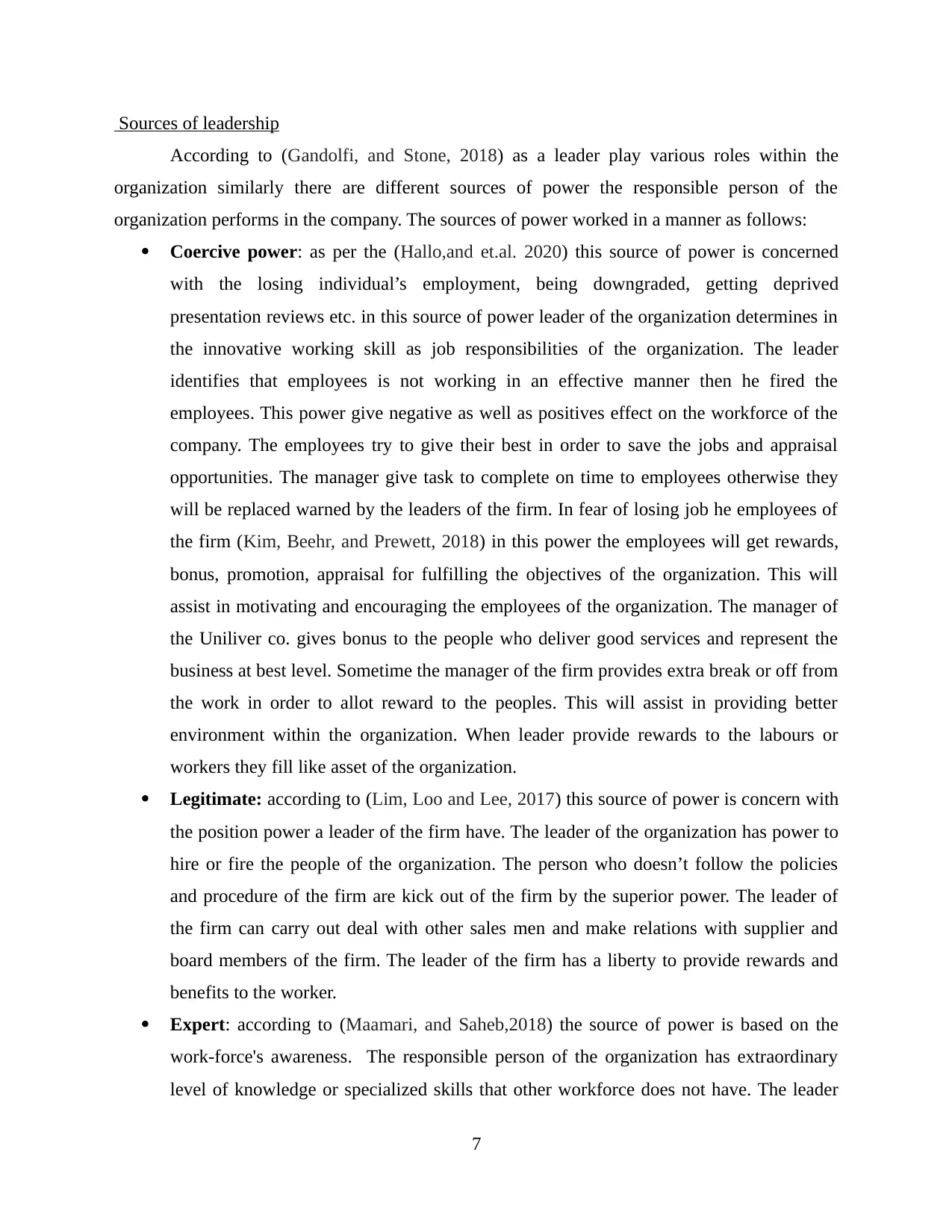
Sources of leadership
According to (Gandolfi, and Stone, 2018) as a leader play various roles within the
organization similarly there are different sources of power the responsible person of the
organization performs in the company. The sources of power worked in a manner as follows:
Coercive power: as per the (Hallo,and et.al. 2020) this source of power is concerned
with the losing individual’s employment, being downgraded, getting deprived
presentation reviews etc. in this source of power leader of the organization determines in
the innovative working skill as job responsibilities of the organization. The leader
identifies that employees is not working in an effective manner then he fired the
employees. This power give negative as well as positives effect on the workforce of the
company. The employees try to give their best in order to save the jobs and appraisal
opportunities. The manager give task to complete on time to employees otherwise they
will be replaced warned by the leaders of the firm. In fear of losing job he employees of
the firm (Kim, Beehr, and Prewett, 2018) in this power the employees will get rewards,
bonus, promotion, appraisal for fulfilling the objectives of the organization. This will
assist in motivating and encouraging the employees of the organization. The manager of
the Uniliver co. gives bonus to the people who deliver good services and represent the
business at best level. Sometime the manager of the firm provides extra break or off from
the work in order to allot reward to the peoples. This will assist in providing better
environment within the organization. When leader provide rewards to the labours or
workers they fill like asset of the organization.
Legitimate: according to (Lim, Loo and Lee, 2017) this source of power is concern with
the position power a leader of the firm have. The leader of the organization has power to
hire or fire the people of the organization. The person who doesn’t follow the policies
and procedure of the firm are kick out of the firm by the superior power. The leader of
the firm can carry out deal with other sales men and make relations with supplier and
board members of the firm. The leader of the firm has a liberty to provide rewards and
benefits to the worker.
Expert: according to (Maamari, and Saheb,2018) the source of power is based on the
work-force's awareness. The responsible person of the organization has extraordinary
level of knowledge or specialized skills that other workforce does not have. The leader
7
According to (Gandolfi, and Stone, 2018) as a leader play various roles within the
organization similarly there are different sources of power the responsible person of the
organization performs in the company. The sources of power worked in a manner as follows:
Coercive power: as per the (Hallo,and et.al. 2020) this source of power is concerned
with the losing individual’s employment, being downgraded, getting deprived
presentation reviews etc. in this source of power leader of the organization determines in
the innovative working skill as job responsibilities of the organization. The leader
identifies that employees is not working in an effective manner then he fired the
employees. This power give negative as well as positives effect on the workforce of the
company. The employees try to give their best in order to save the jobs and appraisal
opportunities. The manager give task to complete on time to employees otherwise they
will be replaced warned by the leaders of the firm. In fear of losing job he employees of
the firm (Kim, Beehr, and Prewett, 2018) in this power the employees will get rewards,
bonus, promotion, appraisal for fulfilling the objectives of the organization. This will
assist in motivating and encouraging the employees of the organization. The manager of
the Uniliver co. gives bonus to the people who deliver good services and represent the
business at best level. Sometime the manager of the firm provides extra break or off from
the work in order to allot reward to the peoples. This will assist in providing better
environment within the organization. When leader provide rewards to the labours or
workers they fill like asset of the organization.
Legitimate: according to (Lim, Loo and Lee, 2017) this source of power is concern with
the position power a leader of the firm have. The leader of the organization has power to
hire or fire the people of the organization. The person who doesn’t follow the policies
and procedure of the firm are kick out of the firm by the superior power. The leader of
the firm can carry out deal with other sales men and make relations with supplier and
board members of the firm. The leader of the firm has a liberty to provide rewards and
benefits to the worker.
Expert: according to (Maamari, and Saheb,2018) the source of power is based on the
work-force's awareness. The responsible person of the organization has extraordinary
level of knowledge or specialized skills that other workforce does not have. The leader
7
Paraphrase This Document
Need a fresh take? Get an instant paraphrase of this document with our AI Paraphraser
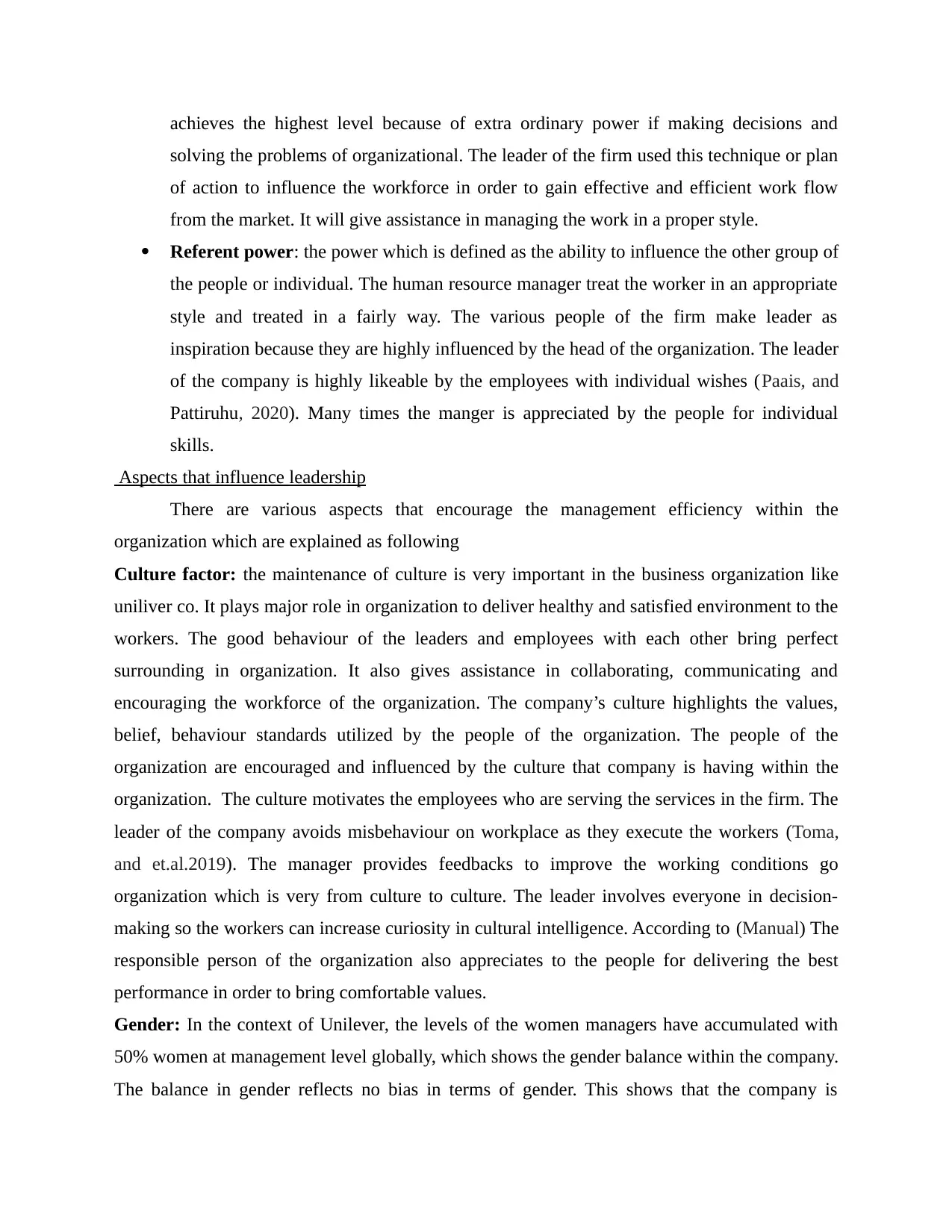
achieves the highest level because of extra ordinary power if making decisions and
solving the problems of organizational. The leader of the firm used this technique or plan
of action to influence the workforce in order to gain effective and efficient work flow
from the market. It will give assistance in managing the work in a proper style.
Referent power: the power which is defined as the ability to influence the other group of
the people or individual. The human resource manager treat the worker in an appropriate
style and treated in a fairly way. The various people of the firm make leader as
inspiration because they are highly influenced by the head of the organization. The leader
of the company is highly likeable by the employees with individual wishes (Paais, and
Pattiruhu, 2020). Many times the manger is appreciated by the people for individual
skills.
Aspects that influence leadership
There are various aspects that encourage the management efficiency within the
organization which are explained as following
Culture factor: the maintenance of culture is very important in the business organization like
uniliver co. It plays major role in organization to deliver healthy and satisfied environment to the
workers. The good behaviour of the leaders and employees with each other bring perfect
surrounding in organization. It also gives assistance in collaborating, communicating and
encouraging the workforce of the organization. The company’s culture highlights the values,
belief, behaviour standards utilized by the people of the organization. The people of the
organization are encouraged and influenced by the culture that company is having within the
organization. The culture motivates the employees who are serving the services in the firm. The
leader of the company avoids misbehaviour on workplace as they execute the workers (Toma,
and et.al.2019). The manager provides feedbacks to improve the working conditions go
organization which is very from culture to culture. The leader involves everyone in decision-
making so the workers can increase curiosity in cultural intelligence. According to (Manual) The
responsible person of the organization also appreciates to the people for delivering the best
performance in order to bring comfortable values.
Gender: In the context of Unilever, the levels of the women managers have accumulated with
50% women at management level globally, which shows the gender balance within the company.
The balance in gender reflects no bias in terms of gender. This shows that the company is
solving the problems of organizational. The leader of the firm used this technique or plan
of action to influence the workforce in order to gain effective and efficient work flow
from the market. It will give assistance in managing the work in a proper style.
Referent power: the power which is defined as the ability to influence the other group of
the people or individual. The human resource manager treat the worker in an appropriate
style and treated in a fairly way. The various people of the firm make leader as
inspiration because they are highly influenced by the head of the organization. The leader
of the company is highly likeable by the employees with individual wishes (Paais, and
Pattiruhu, 2020). Many times the manger is appreciated by the people for individual
skills.
Aspects that influence leadership
There are various aspects that encourage the management efficiency within the
organization which are explained as following
Culture factor: the maintenance of culture is very important in the business organization like
uniliver co. It plays major role in organization to deliver healthy and satisfied environment to the
workers. The good behaviour of the leaders and employees with each other bring perfect
surrounding in organization. It also gives assistance in collaborating, communicating and
encouraging the workforce of the organization. The company’s culture highlights the values,
belief, behaviour standards utilized by the people of the organization. The people of the
organization are encouraged and influenced by the culture that company is having within the
organization. The culture motivates the employees who are serving the services in the firm. The
leader of the company avoids misbehaviour on workplace as they execute the workers (Toma,
and et.al.2019). The manager provides feedbacks to improve the working conditions go
organization which is very from culture to culture. The leader involves everyone in decision-
making so the workers can increase curiosity in cultural intelligence. According to (Manual) The
responsible person of the organization also appreciates to the people for delivering the best
performance in order to bring comfortable values.
Gender: In the context of Unilever, the levels of the women managers have accumulated with
50% women at management level globally, which shows the gender balance within the company.
The balance in gender reflects no bias in terms of gender. This shows that the company is
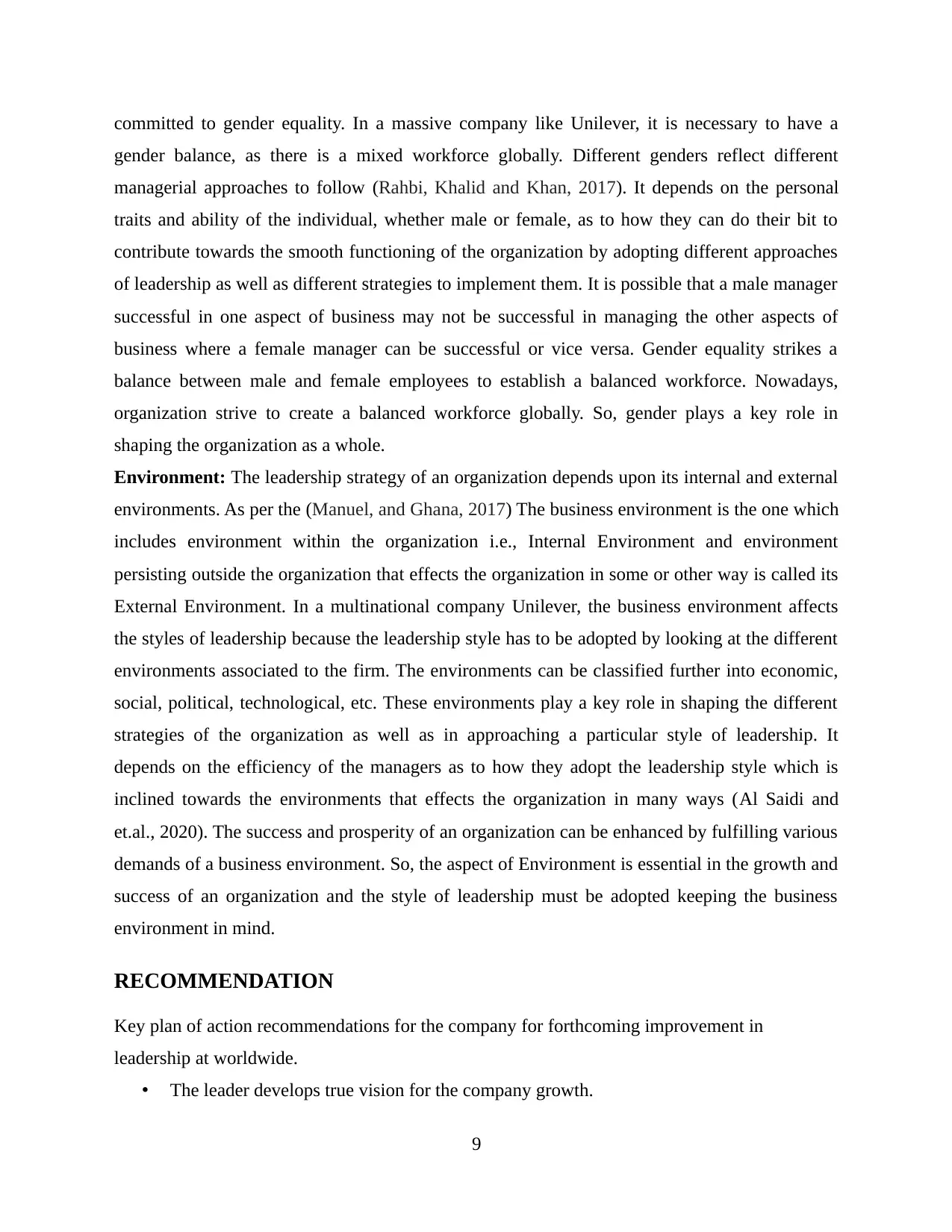
committed to gender equality. In a massive company like Unilever, it is necessary to have a
gender balance, as there is a mixed workforce globally. Different genders reflect different
managerial approaches to follow (Rahbi, Khalid and Khan, 2017). It depends on the personal
traits and ability of the individual, whether male or female, as to how they can do their bit to
contribute towards the smooth functioning of the organization by adopting different approaches
of leadership as well as different strategies to implement them. It is possible that a male manager
successful in one aspect of business may not be successful in managing the other aspects of
business where a female manager can be successful or vice versa. Gender equality strikes a
balance between male and female employees to establish a balanced workforce. Nowadays,
organization strive to create a balanced workforce globally. So, gender plays a key role in
shaping the organization as a whole.
Environment: The leadership strategy of an organization depends upon its internal and external
environments. As per the (Manuel, and Ghana, 2017) The business environment is the one which
includes environment within the organization i.e., Internal Environment and environment
persisting outside the organization that effects the organization in some or other way is called its
External Environment. In a multinational company Unilever, the business environment affects
the styles of leadership because the leadership style has to be adopted by looking at the different
environments associated to the firm. The environments can be classified further into economic,
social, political, technological, etc. These environments play a key role in shaping the different
strategies of the organization as well as in approaching a particular style of leadership. It
depends on the efficiency of the managers as to how they adopt the leadership style which is
inclined towards the environments that effects the organization in many ways (Al Saidi and
et.al., 2020). The success and prosperity of an organization can be enhanced by fulfilling various
demands of a business environment. So, the aspect of Environment is essential in the growth and
success of an organization and the style of leadership must be adopted keeping the business
environment in mind.
RECOMMENDATION
Key plan of action recommendations for the company for forthcoming improvement in
leadership at worldwide.
• The leader develops true vision for the company growth.
9
gender balance, as there is a mixed workforce globally. Different genders reflect different
managerial approaches to follow (Rahbi, Khalid and Khan, 2017). It depends on the personal
traits and ability of the individual, whether male or female, as to how they can do their bit to
contribute towards the smooth functioning of the organization by adopting different approaches
of leadership as well as different strategies to implement them. It is possible that a male manager
successful in one aspect of business may not be successful in managing the other aspects of
business where a female manager can be successful or vice versa. Gender equality strikes a
balance between male and female employees to establish a balanced workforce. Nowadays,
organization strive to create a balanced workforce globally. So, gender plays a key role in
shaping the organization as a whole.
Environment: The leadership strategy of an organization depends upon its internal and external
environments. As per the (Manuel, and Ghana, 2017) The business environment is the one which
includes environment within the organization i.e., Internal Environment and environment
persisting outside the organization that effects the organization in some or other way is called its
External Environment. In a multinational company Unilever, the business environment affects
the styles of leadership because the leadership style has to be adopted by looking at the different
environments associated to the firm. The environments can be classified further into economic,
social, political, technological, etc. These environments play a key role in shaping the different
strategies of the organization as well as in approaching a particular style of leadership. It
depends on the efficiency of the managers as to how they adopt the leadership style which is
inclined towards the environments that effects the organization in many ways (Al Saidi and
et.al., 2020). The success and prosperity of an organization can be enhanced by fulfilling various
demands of a business environment. So, the aspect of Environment is essential in the growth and
success of an organization and the style of leadership must be adopted keeping the business
environment in mind.
RECOMMENDATION
Key plan of action recommendations for the company for forthcoming improvement in
leadership at worldwide.
• The leader develops true vision for the company growth.
9
⊘ This is a preview!⊘
Do you want full access?
Subscribe today to unlock all pages.

Trusted by 1+ million students worldwide
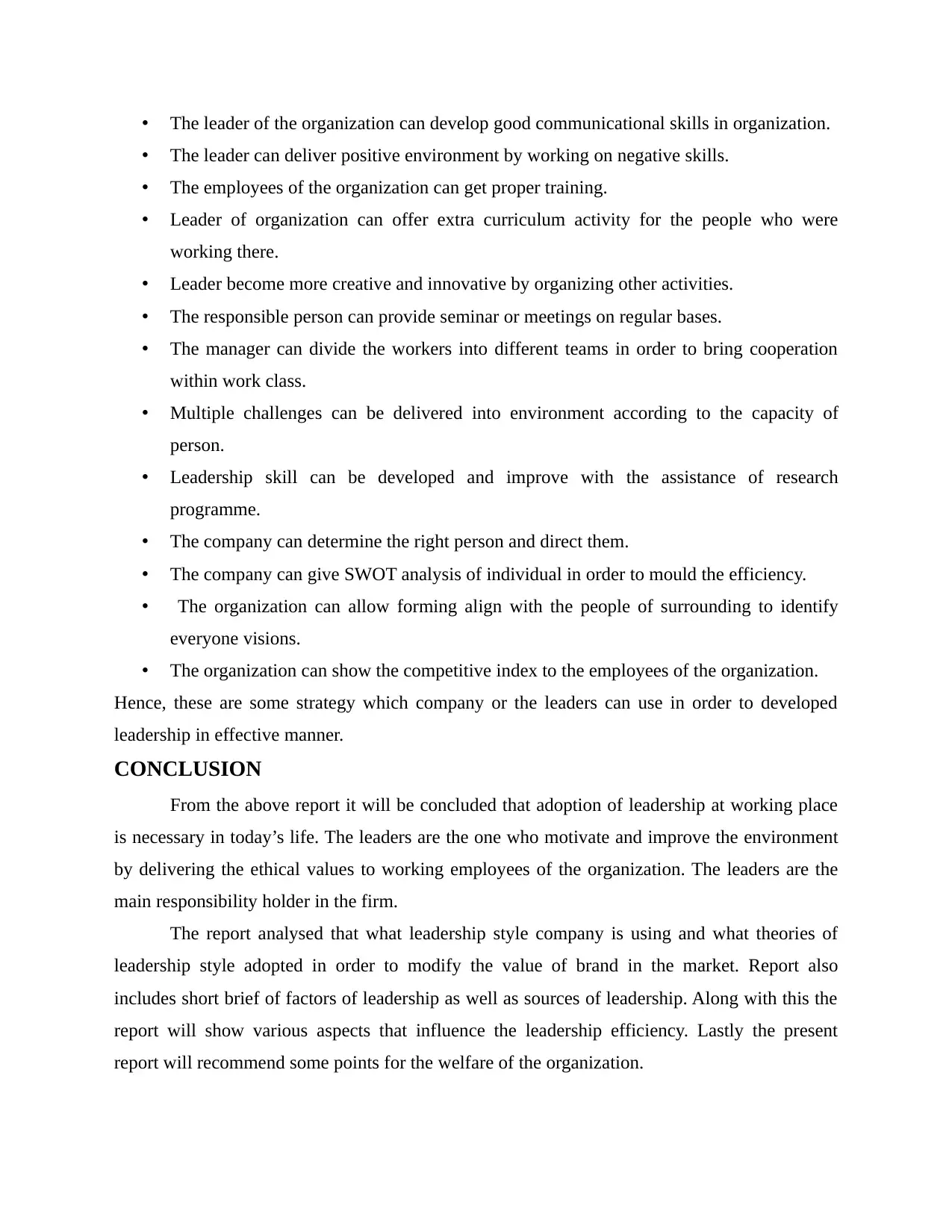
• The leader of the organization can develop good communicational skills in organization.
• The leader can deliver positive environment by working on negative skills.
• The employees of the organization can get proper training.
• Leader of organization can offer extra curriculum activity for the people who were
working there.
• Leader become more creative and innovative by organizing other activities.
• The responsible person can provide seminar or meetings on regular bases.
• The manager can divide the workers into different teams in order to bring cooperation
within work class.
• Multiple challenges can be delivered into environment according to the capacity of
person.
• Leadership skill can be developed and improve with the assistance of research
programme.
• The company can determine the right person and direct them.
• The company can give SWOT analysis of individual in order to mould the efficiency.
• The organization can allow forming align with the people of surrounding to identify
everyone visions.
• The organization can show the competitive index to the employees of the organization.
Hence, these are some strategy which company or the leaders can use in order to developed
leadership in effective manner.
CONCLUSION
From the above report it will be concluded that adoption of leadership at working place
is necessary in today’s life. The leaders are the one who motivate and improve the environment
by delivering the ethical values to working employees of the organization. The leaders are the
main responsibility holder in the firm.
The report analysed that what leadership style company is using and what theories of
leadership style adopted in order to modify the value of brand in the market. Report also
includes short brief of factors of leadership as well as sources of leadership. Along with this the
report will show various aspects that influence the leadership efficiency. Lastly the present
report will recommend some points for the welfare of the organization.
• The leader can deliver positive environment by working on negative skills.
• The employees of the organization can get proper training.
• Leader of organization can offer extra curriculum activity for the people who were
working there.
• Leader become more creative and innovative by organizing other activities.
• The responsible person can provide seminar or meetings on regular bases.
• The manager can divide the workers into different teams in order to bring cooperation
within work class.
• Multiple challenges can be delivered into environment according to the capacity of
person.
• Leadership skill can be developed and improve with the assistance of research
programme.
• The company can determine the right person and direct them.
• The company can give SWOT analysis of individual in order to mould the efficiency.
• The organization can allow forming align with the people of surrounding to identify
everyone visions.
• The organization can show the competitive index to the employees of the organization.
Hence, these are some strategy which company or the leaders can use in order to developed
leadership in effective manner.
CONCLUSION
From the above report it will be concluded that adoption of leadership at working place
is necessary in today’s life. The leaders are the one who motivate and improve the environment
by delivering the ethical values to working employees of the organization. The leaders are the
main responsibility holder in the firm.
The report analysed that what leadership style company is using and what theories of
leadership style adopted in order to modify the value of brand in the market. Report also
includes short brief of factors of leadership as well as sources of leadership. Along with this the
report will show various aspects that influence the leadership efficiency. Lastly the present
report will recommend some points for the welfare of the organization.
Paraphrase This Document
Need a fresh take? Get an instant paraphrase of this document with our AI Paraphraser
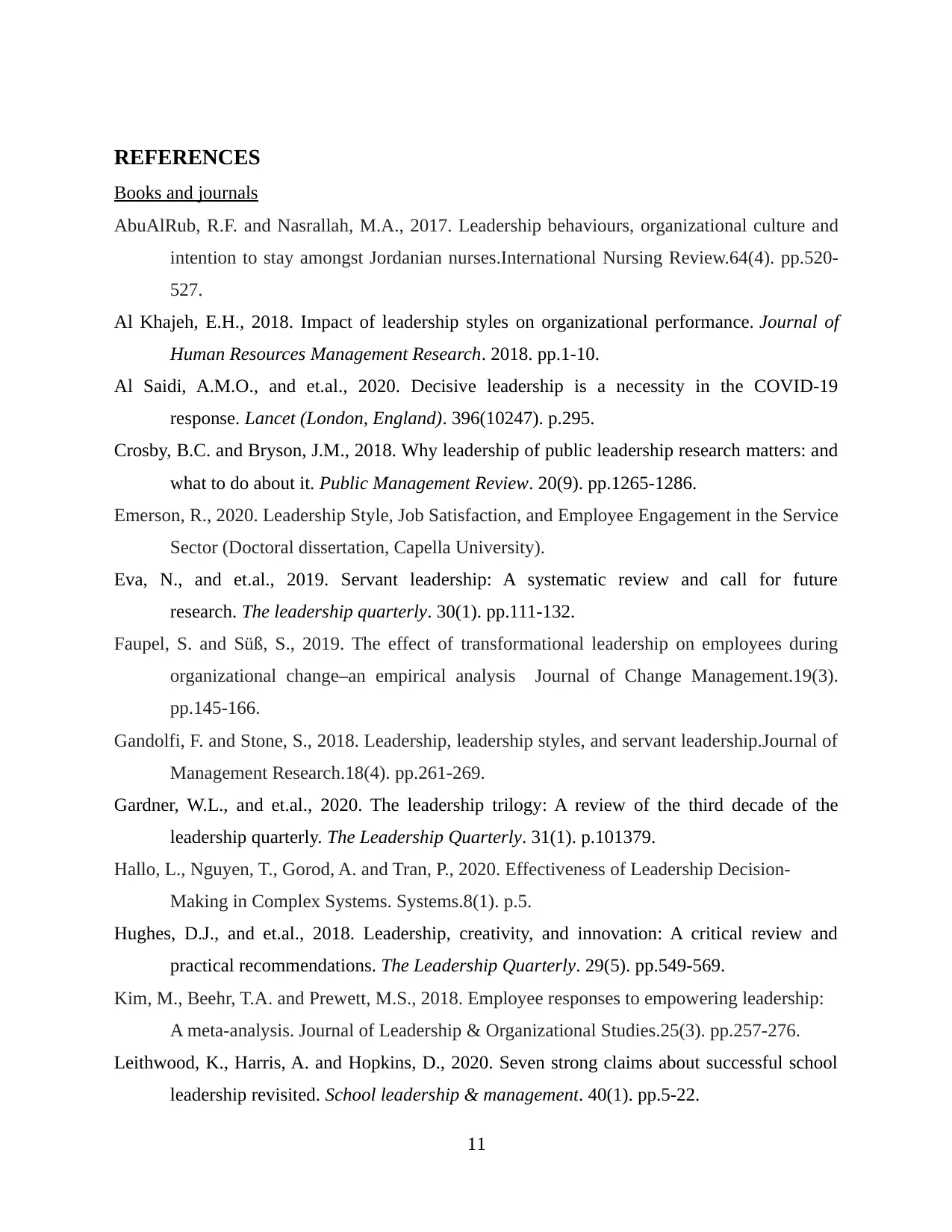
REFERENCES
Books and journals
AbuAlRub, R.F. and Nasrallah, M.A., 2017. Leadership behaviours, organizational culture and
intention to stay amongst Jordanian nurses.International Nursing Review.64(4). pp.520-
527.
Al Khajeh, E.H., 2018. Impact of leadership styles on organizational performance. Journal of
Human Resources Management Research. 2018. pp.1-10.
Al Saidi, A.M.O., and et.al., 2020. Decisive leadership is a necessity in the COVID-19
response. Lancet (London, England). 396(10247). p.295.
Crosby, B.C. and Bryson, J.M., 2018. Why leadership of public leadership research matters: and
what to do about it. Public Management Review. 20(9). pp.1265-1286.
Emerson, R., 2020. Leadership Style, Job Satisfaction, and Employee Engagement in the Service
Sector (Doctoral dissertation, Capella University).
Eva, N., and et.al., 2019. Servant leadership: A systematic review and call for future
research. The leadership quarterly. 30(1). pp.111-132.
Faupel, S. and Süß, S., 2019. The effect of transformational leadership on employees during
organizational change–an empirical analysis Journal of Change Management.19(3).
pp.145-166.
Gandolfi, F. and Stone, S., 2018. Leadership, leadership styles, and servant leadership.Journal of
Management Research.18(4). pp.261-269.
Gardner, W.L., and et.al., 2020. The leadership trilogy: A review of the third decade of the
leadership quarterly. The Leadership Quarterly. 31(1). p.101379.
Hallo, L., Nguyen, T., Gorod, A. and Tran, P., 2020. Effectiveness of Leadership Decision-
Making in Complex Systems. Systems.8(1). p.5.
Hughes, D.J., and et.al., 2018. Leadership, creativity, and innovation: A critical review and
practical recommendations. The Leadership Quarterly. 29(5). pp.549-569.
Kim, M., Beehr, T.A. and Prewett, M.S., 2018. Employee responses to empowering leadership:
A meta-analysis. Journal of Leadership & Organizational Studies.25(3). pp.257-276.
Leithwood, K., Harris, A. and Hopkins, D., 2020. Seven strong claims about successful school
leadership revisited. School leadership & management. 40(1). pp.5-22.
11
Books and journals
AbuAlRub, R.F. and Nasrallah, M.A., 2017. Leadership behaviours, organizational culture and
intention to stay amongst Jordanian nurses.International Nursing Review.64(4). pp.520-
527.
Al Khajeh, E.H., 2018. Impact of leadership styles on organizational performance. Journal of
Human Resources Management Research. 2018. pp.1-10.
Al Saidi, A.M.O., and et.al., 2020. Decisive leadership is a necessity in the COVID-19
response. Lancet (London, England). 396(10247). p.295.
Crosby, B.C. and Bryson, J.M., 2018. Why leadership of public leadership research matters: and
what to do about it. Public Management Review. 20(9). pp.1265-1286.
Emerson, R., 2020. Leadership Style, Job Satisfaction, and Employee Engagement in the Service
Sector (Doctoral dissertation, Capella University).
Eva, N., and et.al., 2019. Servant leadership: A systematic review and call for future
research. The leadership quarterly. 30(1). pp.111-132.
Faupel, S. and Süß, S., 2019. The effect of transformational leadership on employees during
organizational change–an empirical analysis Journal of Change Management.19(3).
pp.145-166.
Gandolfi, F. and Stone, S., 2018. Leadership, leadership styles, and servant leadership.Journal of
Management Research.18(4). pp.261-269.
Gardner, W.L., and et.al., 2020. The leadership trilogy: A review of the third decade of the
leadership quarterly. The Leadership Quarterly. 31(1). p.101379.
Hallo, L., Nguyen, T., Gorod, A. and Tran, P., 2020. Effectiveness of Leadership Decision-
Making in Complex Systems. Systems.8(1). p.5.
Hughes, D.J., and et.al., 2018. Leadership, creativity, and innovation: A critical review and
practical recommendations. The Leadership Quarterly. 29(5). pp.549-569.
Kim, M., Beehr, T.A. and Prewett, M.S., 2018. Employee responses to empowering leadership:
A meta-analysis. Journal of Leadership & Organizational Studies.25(3). pp.257-276.
Leithwood, K., Harris, A. and Hopkins, D., 2020. Seven strong claims about successful school
leadership revisited. School leadership & management. 40(1). pp.5-22.
11
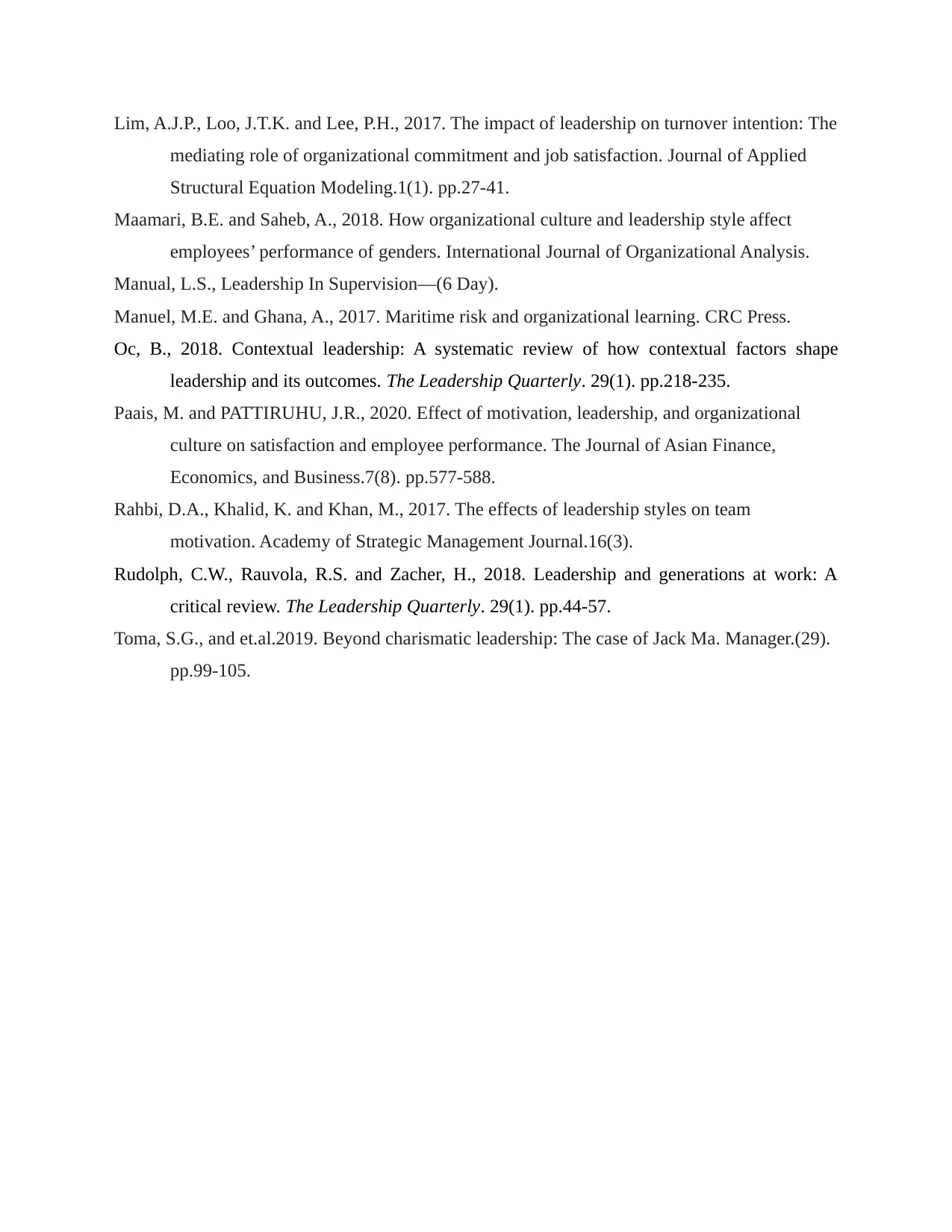
Lim, A.J.P., Loo, J.T.K. and Lee, P.H., 2017. The impact of leadership on turnover intention: The
mediating role of organizational commitment and job satisfaction. Journal of Applied
Structural Equation Modeling.1(1). pp.27-41.
Maamari, B.E. and Saheb, A., 2018. How organizational culture and leadership style affect
employees’ performance of genders. International Journal of Organizational Analysis.
Manual, L.S., Leadership In Supervision—(6 Day).
Manuel, M.E. and Ghana, A., 2017. Maritime risk and organizational learning. CRC Press.
Oc, B., 2018. Contextual leadership: A systematic review of how contextual factors shape
leadership and its outcomes. The Leadership Quarterly. 29(1). pp.218-235.
Paais, M. and PATTIRUHU, J.R., 2020. Effect of motivation, leadership, and organizational
culture on satisfaction and employee performance. The Journal of Asian Finance,
Economics, and Business.7(8). pp.577-588.
Rahbi, D.A., Khalid, K. and Khan, M., 2017. The effects of leadership styles on team
motivation. Academy of Strategic Management Journal.16(3).
Rudolph, C.W., Rauvola, R.S. and Zacher, H., 2018. Leadership and generations at work: A
critical review. The Leadership Quarterly. 29(1). pp.44-57.
Toma, S.G., and et.al.2019. Beyond charismatic leadership: The case of Jack Ma. Manager.(29).
pp.99-105.
mediating role of organizational commitment and job satisfaction. Journal of Applied
Structural Equation Modeling.1(1). pp.27-41.
Maamari, B.E. and Saheb, A., 2018. How organizational culture and leadership style affect
employees’ performance of genders. International Journal of Organizational Analysis.
Manual, L.S., Leadership In Supervision—(6 Day).
Manuel, M.E. and Ghana, A., 2017. Maritime risk and organizational learning. CRC Press.
Oc, B., 2018. Contextual leadership: A systematic review of how contextual factors shape
leadership and its outcomes. The Leadership Quarterly. 29(1). pp.218-235.
Paais, M. and PATTIRUHU, J.R., 2020. Effect of motivation, leadership, and organizational
culture on satisfaction and employee performance. The Journal of Asian Finance,
Economics, and Business.7(8). pp.577-588.
Rahbi, D.A., Khalid, K. and Khan, M., 2017. The effects of leadership styles on team
motivation. Academy of Strategic Management Journal.16(3).
Rudolph, C.W., Rauvola, R.S. and Zacher, H., 2018. Leadership and generations at work: A
critical review. The Leadership Quarterly. 29(1). pp.44-57.
Toma, S.G., and et.al.2019. Beyond charismatic leadership: The case of Jack Ma. Manager.(29).
pp.99-105.
⊘ This is a preview!⊘
Do you want full access?
Subscribe today to unlock all pages.

Trusted by 1+ million students worldwide
1 out of 12
Related Documents
Your All-in-One AI-Powered Toolkit for Academic Success.
+13062052269
info@desklib.com
Available 24*7 on WhatsApp / Email
![[object Object]](/_next/static/media/star-bottom.7253800d.svg)
Unlock your academic potential
Copyright © 2020–2025 A2Z Services. All Rights Reserved. Developed and managed by ZUCOL.





